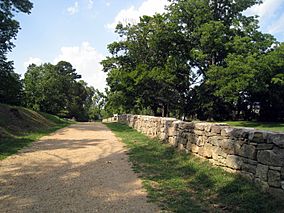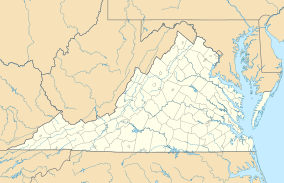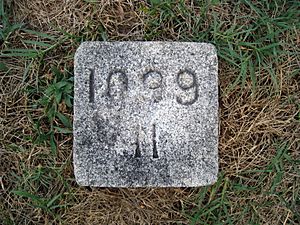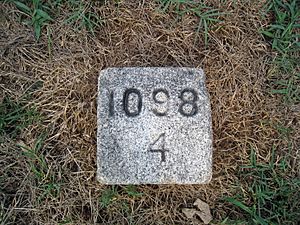Fredericksburg and Spotsylvania National Military Park facts for kids
Quick facts for kids Fredericksburg and Spotsylvania National Military Park |
|
|---|---|

The stone wall along Sunken Road, in Fredericksburg
|
|
| Location | Spotsylvania County and Fredericksburg counties, U.S. |
| Nearest city | Fredericksburg, Virginia, U.S. |
| Area | 8,405 acres (34.01 km2) |
| Established | February 14, 1927 |
| Visitors | 534,636 (in 2005) |
| Governing body | National Park Service |
| Website | Fredericksburg & Spotsylvania National Military Park |
|
Fredericksburg and Spotsylvania County Battlefields Memorial National Military Park
|
|
| Area | 4,601.1 acres (1,862 ha) |
| NRHP reference No. | 66000046 |
| Significant dates | |
| Added to NRHP | October 15, 1966 |
The Fredericksburg and Spotsylvania National Military Park is a special place in Fredericksburg, Virginia, and Spotsylvania County. It is managed by the National Park Service. This park helps us remember four very important battles from the American Civil War. These battles were Fredericksburg, Chancellorsville, The Wilderness, and Spotsylvania.
Contents
Remembering Key Civil War Battles
This park protects the sites where some of the toughest battles of the Civil War happened. Learning about these battles helps us understand a big part of American history.
The Battle of Fredericksburg
- When it happened: December 11–15, 1862
During this battle, Union General Ambrose Burnside tried to cross the Rappahannock River. His goal was to capture Richmond, the capital of the Confederate states. However, his special bridges (pontoons) arrived late. This delay gave Confederate General Robert E. Lee time to build strong defenses on high ground. The battle became a terrible defeat for the Union army. You can visit a special center here with park rangers to learn more.
The Battle of Chancellorsville
- When it happened: May 1–3, 1863
General Robert E. Lee took a big risk in this battle. He split his army and sent General Stonewall Jackson on a surprise attack around the Union forces. This move completely shocked the Union commander, General Joseph Hooker. Hooker lost his confidence and ordered his troops to retreat. There is also a visitor center here with park rangers.
The Battle of the Wilderness
- When it happened: May 5–7, 1864
This was the first time Robert E. Lee fought against Union General Ulysses S. Grant. The battle took place in a very thick forest. This dense forest made it hard for Grant to use his powerful cannons. Many soldiers were hurt or killed on both sides. The battle ended without a clear winner. Grant pulled back, but only to find a more open area for the next fight. You can find exhibit shelters here, sometimes with staff.
The Battle of Spotsylvania
- When it happened: May 8–21, 1864
General Grant wanted to take control of a key crossroads at Spotsylvania. He hoped to keep his army between Lee's forces and Richmond. But Lee's army got there just before Grant's. Heavy rain made the gunpowder wet, which led to intense hand-to-hand fighting. This means soldiers fought very closely without much gunfire. Exhibit shelters are available here, sometimes with staff.
The park also looks after four important old buildings connected to these battles. These include Chatham Manor, Salem Church, Ellwood Manor, and the house where Stonewall Jackson died. You can also see the remains of the Chancellor family mansion. Chatham Manor is open every day, and all the sites are free to visit.
History of the Park
The park was officially created on February 14, 1927. Its original, very long name was "Fredericksburg and Spotsylvania County Battlefields Memorial National Military Park." This name, with 75 letters, is the longest official name for any unit in the national park system! In 1933, it became part of the National Park Service.
On October 15, 1966, the park was added to the National Register of Historic Places. This list includes important historical sites across the country. The park covers about 8,374 acres (about 33.89 square kilometers). The U.S. government owns most of this land. More than 500,000 people visit these battlefields each year to learn about history.
Fredericksburg National Cemetery
The Fredericksburg National Cemetery was created in July 1865. This was after the Civil War ended and the states were reunited. It was made to honor the Federal soldiers who died in the local battles or from sickness. The cemetery is located on Marye's Heights, which was a strong Confederate position during the Battle of Fredericksburg.
There are 15,243 Civil War soldiers buried here. However, only 2,473 of them were identified by name.
How Soldiers are Buried
The graves of known and unknown soldiers look different. Soldiers who were identified have their own graves. These are marked with a rounded headstone that shows the soldier's name and their home state.
Unknown soldiers were buried together in mass graves. The headstones for these plots have two numbers. The top number tells you which plot it is. The bottom number tells you how many soldiers are buried in that plot.
About 100 soldiers from the 20th century are also buried in the cemetery. In some cases, their spouses are buried next to them. New burials were allowed until 1945.
Willis Cemetery and Marye's Heights
There is another cemetery called Willis Cemetery on Marye's Heights. It was there before the Civil War and served local families. You can tell it apart from the Civil War burials by its brick wall. The Willis family home burned down before the war started. It was separated from the Marye family home, Brompton, by a small dip in the ridge. The whole ridge became known as Marye's Heights after the battle was reported in newspapers in 1863.
The Bivouac of the Dead Poem
Near the 127th Pennsylvania Volunteer Monument, and in other spots around the cemetery, you'll find plaques. These plaques have verses from a poem called "The Bivouac of the Dead." Theodore O'Hara wrote this poem in 1847. He wrote it to honor American soldiers who died in the Battle of Buena Vista during the Mexican–American War.
Here are some of the verses displayed in the cemetery:
The muffled drum's sad roll has beat
The soldier's last Tattoo;
No more on life's parade shall meet
That brave and fallen few.
On fame's eternal camping ground
Their silent tents to spread,
And glory guards, with solemn round
The bivouac of the dead.
No rumor of the foe's advance
Now swells upon the wind;
Nor troubled thought at midnight haunts
Of loved ones left behind;
No vision of the morrow's strife
The warrior's dreams alarms;
No braying horn or screaming fife
At dawn shall call to arms.
Rest on, embalmed and sainted dead,
Dear as the blood ye gave,
No impious footstep here shall tread
The herbage of your grave.
Monuments and Memorials
Several monuments and memorials are located in the Fredericksburg National Cemetery:
- 127th Pennsylvania Volunteer Monument
- Fifth Corps Monument (dedicated in 1901)
- Humphreys' Division Monument
- Moesch Monument
- Parker's Battery Memorial
Images for kids
-
Cannon preserved at the Chancellorsville Battlefield
-
"Longstreet's Line" on Marye's Heights
-
Fifth Corps Monument erected by Daniel Butterfield
-
Richard Rowland Kirkland Monument (dedicated 1965)
More Information
- National Park Service: Fredericksburg and Spotsylvania National Military Park
- Chatham Plantation: Witness to the Civil War, a National Park Service Teaching with Historic Places (TwHP) lesson plan
- Roster of Known Union Soldiers buried at Fredericksburg B-surname PDF file
- Roster of Known Union Soldiers buried at Fredericksburg O-surname PDF file
-
- Geographic Names Information System Map Data
- 1740060 – Fredericksburg Battlefield Visitors Center – 38°17′33″N 77°28′01″W / 38.29250°N 77.46694°W
- 1488838 – Battlefields Memorial National Military Park – 38°18′13″N 77°44′20″W / 38.30361°N 77.73889°W
- 1466863 – Fredericksburg Battlefield – 38°15′32″N 77°27′52″W / 38.25889°N 77.46444°W
- 1467169 – Confederate Cemetery [Spotsylvania] – 38°12′10″N 77°34′59″W / 38.20278°N 77.58306°W
- 1478416 – Fredericksburg Confederate Cemetery – 38°18′09″N 77°28′02″W / 38.30250°N 77.46722°W
- 1479187 & 2766709 – Fredericksburg National Cemetery – 38°17′34″N 77°28′09″W / 38.29278°N 77.46917°W
de:Fredericksburg Confederate Cemetery
























